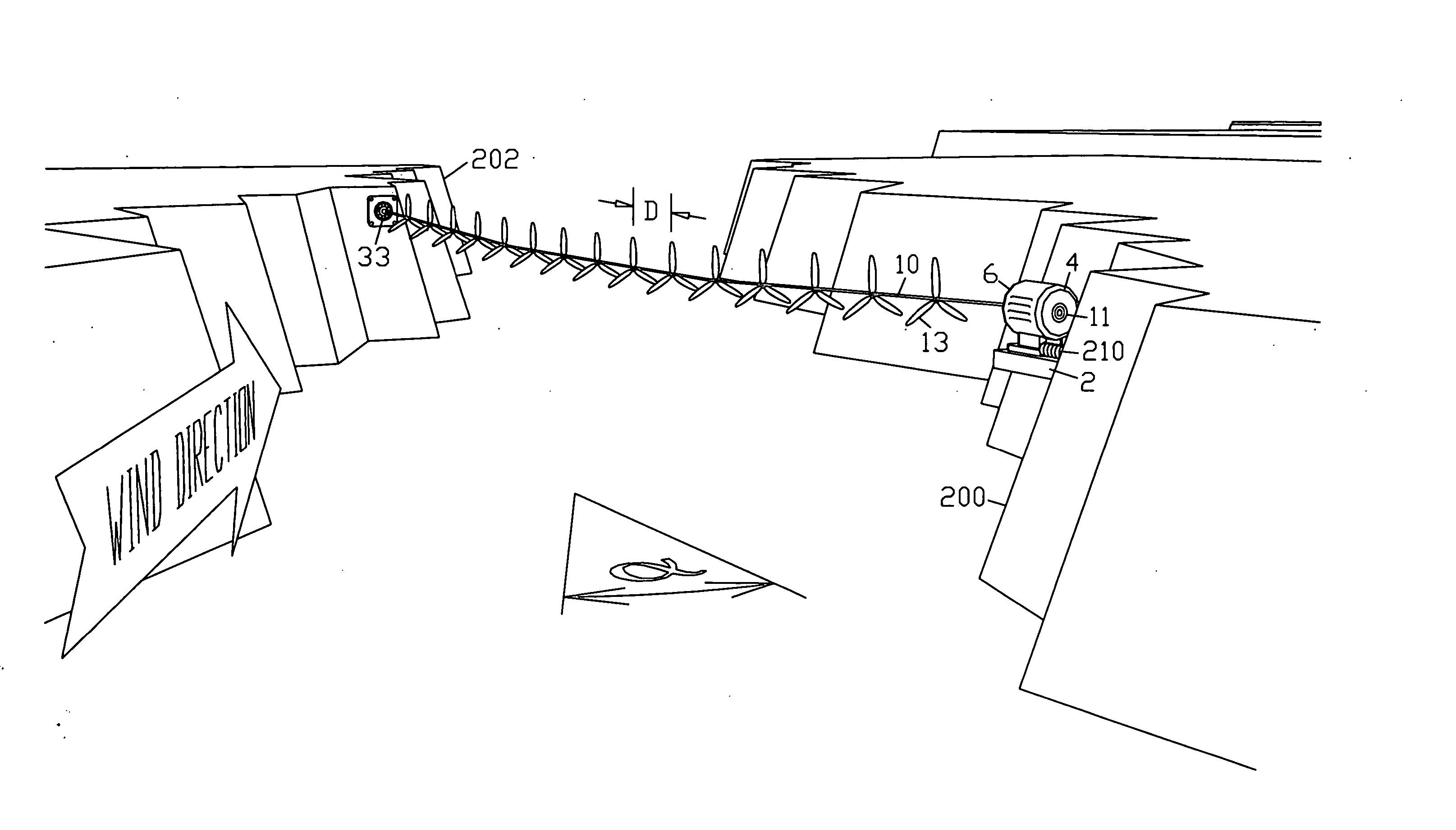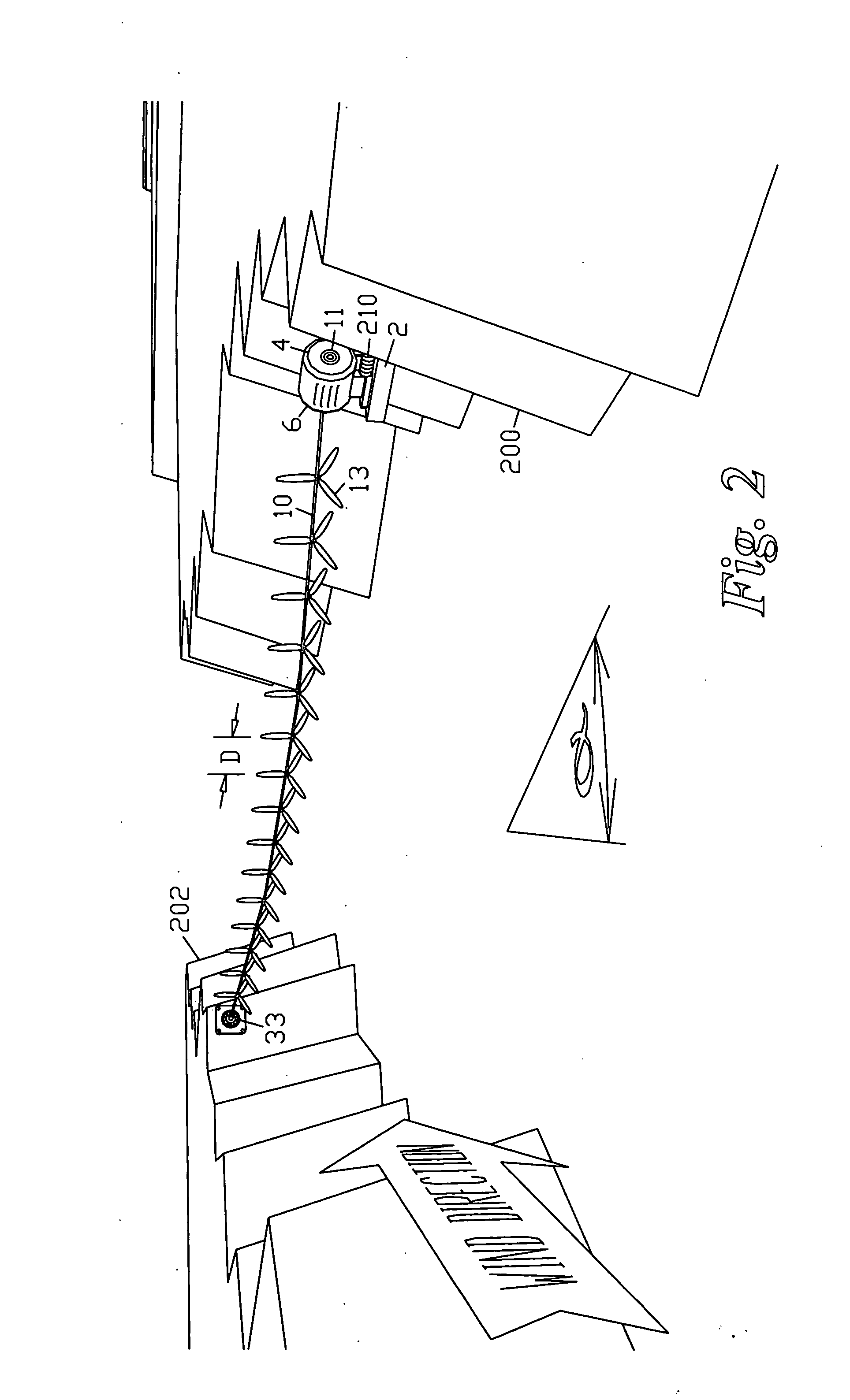Stationary co-axial multi-rotor wind turbine supported by continuous central driveshaft
a coaxial, wind turbine technology, applied in the direction of machines/engines, renewable energy generation, greenhouse gas reduction, etc., to achieve the effect of less required stiffness, less cost, and less required stiffness
- Summary
- Abstract
- Description
- Claims
- Application Information
AI Technical Summary
Benefits of technology
Problems solved by technology
Method used
Image
Examples
second embodiment
2. Stationary Co-Axial, Multi-Rotor-Turbine Spanning a Canyon, Supported from Three or More Points; FIG. 7:
[0093] The second embodiment is similar to the first embodiment, with the addition of one or more intermediate supports 220 for the driveshaft, such as a tower 90 supporting bearing 11 of FIG. 7, added to help elevate and stabilize the driveshaft, and reduce or even replace the required driveshaft stiffness and / or tension, Such intermediate supports may be additionally include one or more stabilizing structures such as horizontal guy wires 57, of FIG. 7. Slanting guy wires 55 could also be used as in FIG. 14. Such intermediate supports may also stabilize the driveshaft against the aggregate side thrust force exerted by the wind on the rotors. Guy wires 57 greatly aid in stabilizing the side-to side position of the driveshaft, and may prevent unwanted oscillations. Alternatively, such intermediate supports may be suspended from above (not illustrated). For example the intermedia...
third embodiment
3. Multiple Suspended Catenary Co-Axial, Multi-Rotor Turbines Spanning a Canyon; FIG. 6:
[0094] Multiple turbines similar to that of the first embodiment, may be placed across the same canyon. FIG. 6 shows such a multiplicity of turbines placed in a vertical array, in effect forming a wall of rotors through which the winds must pass to continue transit through the canyon. The result is a further multiplication of the total power output.
[0095] 4. Fourth Embodiment—FIG. 7: Similar to the third embodiment, multiple turbines span the canyon in a vertical array, but with staggered rotor spacing between adjacent driveshafts, allowing the driveshafts to be placed in closer mutual proximity, while yet avoiding blade strikes between adjacent turbines, which allows more driveshafts to be included in the array. The result is an increase in the total number of rotors, an increase in the aggregate solidity of the “wall of rotors”, and an increase in total power output.
5. Fifth Embodiment—FIG. ...
sixth embodiment
6. Multiple Suspended Catenary Co-Axial, Multi-Rotor Turbines Spanning Gap Between Buildings; FIG. 8:
[0101] This embodiment is similar to the fifth embodiment, a stationary, vertical array of co-axial, multi-rotor turbines, with rotors 13 staggered from one driveshaft 10 to the next, and intermediate supports 220, comprising tower 90, to help elevate and stabilize the driveshafts, allowing closer driveshaft spacing while avoiding blade strikes, for a higher density of turbines, yielding more power. Instead of a canyon, this array spans the gap between two buildings, strategically placed so that wind is focused or concentrated between them, with a line between a corner of each building falling at offset angle α (alpha) to the wind direction. The vertical array of Co-axial, multi-rotor turbines extends between these two corners. The buildings are angled so that the exterior side surfaces of the buildings serve as a narrowing funnel, to concentrate the wind before it reaches the turbin...
PUM
 Login to View More
Login to View More Abstract
Description
Claims
Application Information
 Login to View More
Login to View More - R&D
- Intellectual Property
- Life Sciences
- Materials
- Tech Scout
- Unparalleled Data Quality
- Higher Quality Content
- 60% Fewer Hallucinations
Browse by: Latest US Patents, China's latest patents, Technical Efficacy Thesaurus, Application Domain, Technology Topic, Popular Technical Reports.
© 2025 PatSnap. All rights reserved.Legal|Privacy policy|Modern Slavery Act Transparency Statement|Sitemap|About US| Contact US: help@patsnap.com



